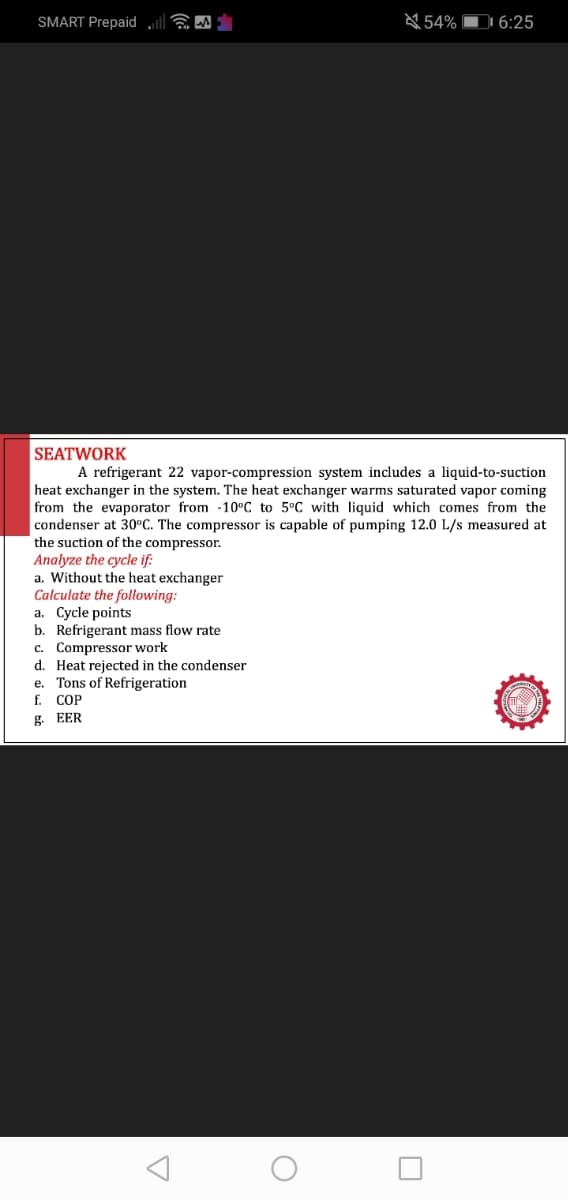SEATWORK A refrigerant 22 vapor-compression system includes a liquid-to-suction heat exchanger in the system. The heat exchanger warms saturated vapor coming from the evaporator from -10°C to 5°C with liquid which comes from the condenser at 30°C. The compressor is capable of pumping 12.0 L/s measured at the suction of the compressor. Analyze the cycle if: a. Without the heat exchanger Calculate the following: a. Cycle points b. Refrigerant mass flow rate c. Compressor work d. Heat rejected in the condenser e. Tons of Refrigeration f. COP g. EER KATY
SEATWORK A refrigerant 22 vapor-compression system includes a liquid-to-suction heat exchanger in the system. The heat exchanger warms saturated vapor coming from the evaporator from -10°C to 5°C with liquid which comes from the condenser at 30°C. The compressor is capable of pumping 12.0 L/s measured at the suction of the compressor. Analyze the cycle if: a. Without the heat exchanger Calculate the following: a. Cycle points b. Refrigerant mass flow rate c. Compressor work d. Heat rejected in the condenser e. Tons of Refrigeration f. COP g. EER KATY
Refrigeration and Air Conditioning Technology (MindTap Course List)
8th Edition
ISBN:9781305578296
Author:John Tomczyk, Eugene Silberstein, Bill Whitman, Bill Johnson
Publisher:John Tomczyk, Eugene Silberstein, Bill Whitman, Bill Johnson
Chapter22: Condensers
Section: Chapter Questions
Problem 7RQ: When a standard-efficiency air-cooled condenser is used, the condensing refrigerant will normally be...
Related questions
Question

Transcribed Image Text:SMART Prepaid
M
SEATWORK
A refrigerant 22 vapor-compression system includes a liquid-to-suction
heat exchanger in the system. The heat exchanger warms saturated vapor coming
from the evaporator from -10°C to 5°C with liquid which comes from the
condenser at 30°C. The compressor is capable of pumping 12.0 L/s measured at
the suction of the compressor.
Analyze the cycle if:
a. Without the heat exchanger
Calculate the following:
a. Cycle points
b. Refrigerant mass flow rate
c. Compressor work
d. Heat rejected in the condenser
e. Tons of Refrigeration
f.
COP
g. EER
▼
54% 6:25
O
Expert Solution
This question has been solved!
Explore an expertly crafted, step-by-step solution for a thorough understanding of key concepts.
Step by step
Solved in 2 steps with 3 images

Knowledge Booster
Learn more about
Need a deep-dive on the concept behind this application? Look no further. Learn more about this topic, mechanical-engineering and related others by exploring similar questions and additional content below.Recommended textbooks for you

Refrigeration and Air Conditioning Technology (Mi…
Mechanical Engineering
ISBN:
9781305578296
Author:
John Tomczyk, Eugene Silberstein, Bill Whitman, Bill Johnson
Publisher:
Cengage Learning

Refrigeration and Air Conditioning Technology (Mi…
Mechanical Engineering
ISBN:
9781305578296
Author:
John Tomczyk, Eugene Silberstein, Bill Whitman, Bill Johnson
Publisher:
Cengage Learning